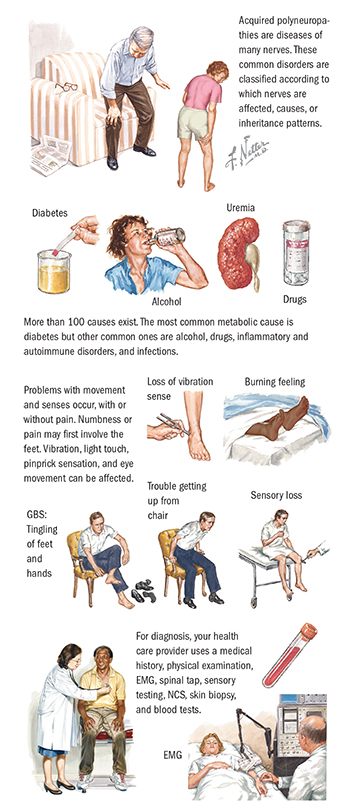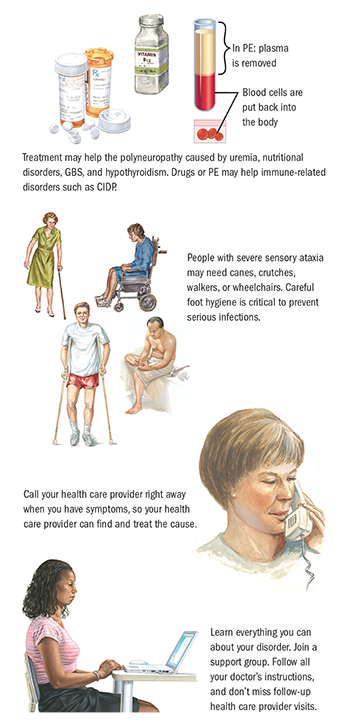
Acquired polyneuropathies are diseases of many nerves affected simultaneously. Acquired means caused by some other disease or exposure. Therefore, acquired polyneuropathy isn’t really a diagnosis. Instead, it indicates the presence of some disease. These are one of the most common nervous system disorders. They’re classified according to which type of nerve (e.g., sensory, motor, autonomic), which nerves, and which parts of nerves are affected. Other classes are based on causes or pattern of inheritance.
Examples include Guillain-Barré syndrome (GBS), plexopathies, chronic inflammatory demyelinating polyneuropathy (CIDP), and paraneoplastic sensory neuronopathy (PSN) caused by small cell lung cancer.
More than 100 causes exist. The most common metabolic cause is diabetes. Other common ones are hypothyroidism, uremia from kidney failure, and deficiencies of nutrients (vitamin B12). Alcohol and cancer treatment drugs can cause toxic neuropathies. Inflammatory and autoimmune disorders include GBS, amyloidosis, Sjögren syndrome, sarcoidosis, and CIDP. Infections (HIV, Lyme disease) are other causes. In 30–40% of people, no cause can be found (idiopathic neuropathy).
Symptoms depend on the cause. They include problems with movement (motor nerves) and senses (sensory nerves) that occur on both sides of the body. Sensory symptoms may be painful (burning, freezing, throbbing) or painless (tingling, swelling). Numbness or pain may first involve the feet, then legs, fingers, hands, and arms. Vibration, light touch, and pinprick sensations are affected. Weakness and wasting of feet and legs may occur. Eye movement can be affected. Symptoms can get worse with heat exposure, physical activity, or tiredness.
The health care provider takes a medical history and does a physical examination. The health care provider may also order electromyography (EMG), spinal fluid analysis (spinal tap), sensory testing, nerve conduction studies (NCS), and skin biopsy. Blood tests, such as for vitamin B12 levels, are also done.

When a cause is found, treatment may help the polyneuropathy. Examples include treatment of uremia, nutritional deficiencies (vitamin B12 replacement therapy), GBS, and hypothyroidism. Stopping neurotoxic drugs may reverse mild neuropathies or prevent severe cases from getting worse. Prednisone, immunoglobulin, or plasmapheresis (PE) may help immune-related disorders such as CIDP. In PE, whole blood is withdrawn from the body and the fluid part (plasma) is removed. Blood cells are then returned to the body. Drugs may help symptoms. People with severe sensory ataxia may need canes, crutches, walkers, or wheelchairs. Ataxia means lack of coordination while making voluntary movements. Careful foot hygiene is critical when pain perception is lost. It can prevent serious infections.
Contact the following source:
Copyright © 2016 by Saunders, an imprint of Elsevier, Inc.
Ferri’s Netter Patient Advisor